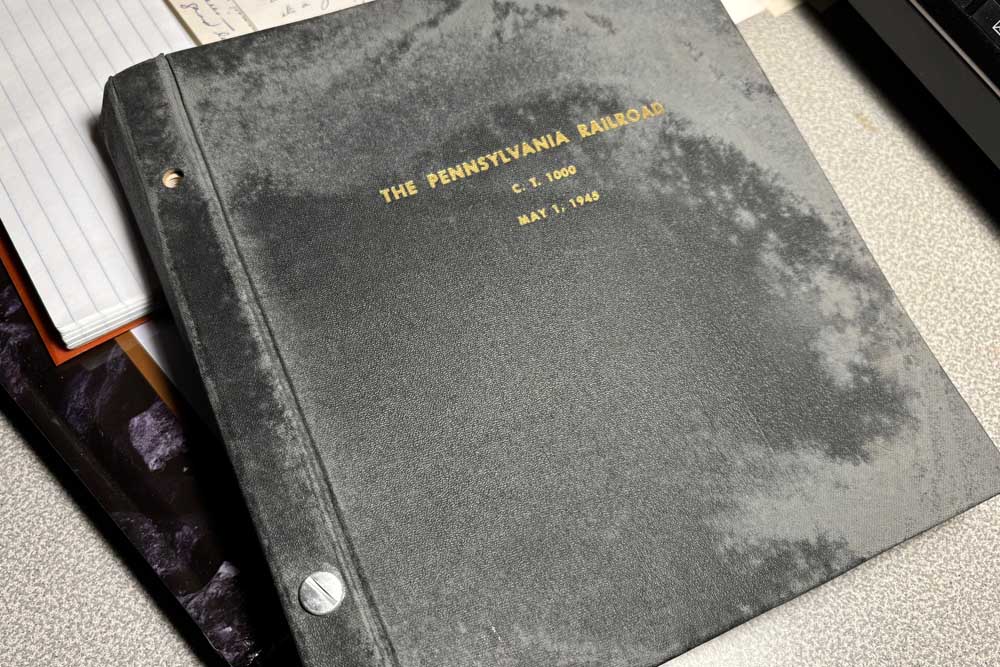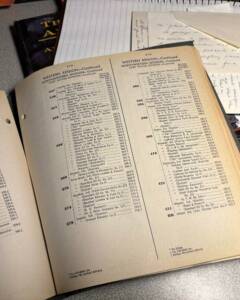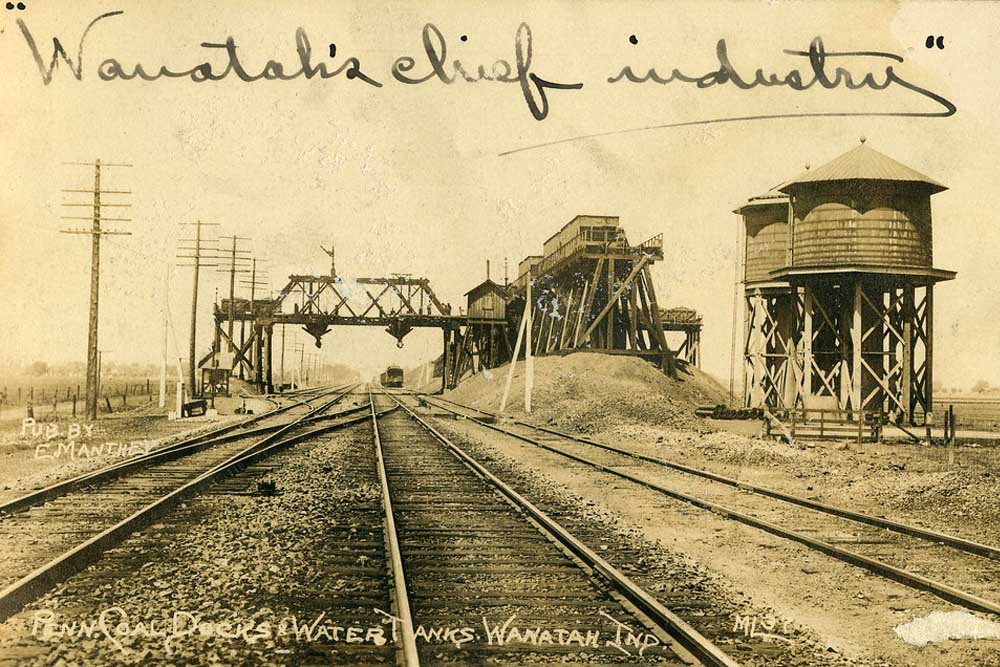
Like some railfan contemporaries, in recent weeks I’ve been going through decades of railroad stuff, seeing what I can get rid of and what I simply can’t live without. Tough choices. In the “can’t live without” category, anything with David P. Morgan’s name on it, or anything labeled “New York Central” or “C&EI.” In the “out” pile, a variety of things.
Digging through the geologic periods of my life, one layer of sediment yielded a stunning surprise. Not only for its antiquity — a document that dates back to 1945, before I was born — but also for an expected bit of wisdom that fell out of its pages.
Let me back up. Friends know me to be a hardcore NYC fan. It’s the railroad I know best, having grown up along its Detroit-Chicago main line. Later in life, that Central loyalty led to a friendly rivalry with my colleague Rob McGonigal, longtime editor of Classic Trains and widely known to be deeply in the Pennsylvania Railroad camp. His youthful experiences along the PRR in Philadelphia were felt as intensely as mine in Michigan.
The fact is, though, I’ve always loved the Pennsy nearly as much as Rob, thanks to more than 70 years of periodic visits to Philadelphia, where my beloved aunt, Rita Macintosh, fanned the flames for what she called the “P Company.” Rita grew up in Rockford, Ill., but after 1945 lived in the Philly neighborhood of Mount Airy. A force of nature (she was in the first class of Navy WAVES in World War II), she died in 2011 at age 94.
My first visit to Philadelphia came around 1955, when I was four, and it involved an overnight train ride from Chicago with my parents. I’d like to think it was aboard train 28, the Broadway Limited, but it’s more likely we were on less glamorous train 48, the General, or train 70, the Admiral. You can’t really trust the memories of 4-year-olds, but one undeniable experience was my dad tucking me into an upper berth and securing the netting, giving a new meaning to the word “cozy.”
During visits over the years Aunt Rita and Uncle Mac got me to a lot of great places, from watching lordly GG1s stream past the platforms at North Philadelphia to catching an occasional MP54 at the Carpenter station near their house to standing in awe beneath the coffered ceiling of 30th Street Station. The “Macs,” as we knew them, hardly were railfans, but in those days you couldn’t live in Philadelphia without being steeped in things PRR, and they made sure it rubbed off on me.

Thus, I shouldn’t have been surprised when a PRR artifact surfaced the other day among a pile of railroad books and timetables. It was a curious volume with a plain black leatherette cover (water-stained and smelling a bit musty) with this obscure reference stamped in gold: “The Pennsylvania Railroad, C.T. 1000, May 1, 1945.” Opening it up, I discovered hundreds of pages listing every siding, every switch, every depot, every junction across the entire nearly 12,000-mile PRR system, each carrying a milepost number. I instinctively called McGonigal.
“You have one of those?” Rob asked. I could tell it was something special.
It turns out the PRR was among a few railroads who created such obsessively detailed official books, but it seems to have acquired a special appeal in the Pennsy community; I read somewhere that on the PRR, “C.T.” stands for “conducting transportation.” I found a few mentions of it online; one listing had the book for sale for $75. Rob quickly made an offer, but I rebuffed him with “relax, man, you can have it.” Something like this deserves a good Tuscan-red home.
Before I handed the book over to Rob, I leafed through it, checking out various Pennsy places that meant something to me: Horseshoe Curve, Zoo Interlocking, or, most exotic of all to me, the depot and yard way up in Mackinaw City, Mich., the furthest outpost on the railroad, depending on your perspective.

I also lingered awhile on the listing for Wanatah, in northwest Indiana, a lonely place I visited several years ago. It was at Wanatah that the PRR constructed a huge, mainline-straddling coaling station, just east of the railroad’s crossing of the Monon’s Michigan City branch, as captured here on film by veteran PRR engineer (and chronicler) John R. Crosby. The photo, which shows Q2 duplex 4-4-6-4 No. 6198, caught my attention years ago and I thought “I gotta see where this was.”
The C.T. listing for Wanatah describes Pennsy trackage between Milepost 414.7 (from Pittsburgh) and the Chicago, Indianapolis & Louisville (Monon) tower at 415.8. In between were tenth-of-a-mile listings for, in succession: the coaling station, the Monon connection, a separate passing siding, the Wanatah depot, and a spur to the Wanatah Mercantile Co. An amazing amount of railroading, all packed into a mere 1.1 miles. And the book has 825 pages of it.
Eventually it was time to pack it up and take it over to Rob’s house. But there was yet another surprise: a tiny piece of note paper fell out of the book. It was from Rita, dated September 10, 1973, explaining that “PRR C.T. 1000” was a gift in honor of my recent graduation from Michigan State. I hadn’t seen the note in 50 years, and to be honest with you, I’m not sure I saw it when the book arrived. The discovery floored me.
Rita was a wise woman, alert to the symbolism of things, especially for a nephew getting out of college. So, for this 22-year-old, she turned the story of the Pennsylvania Railroad — by 1973 a still-raw casualty of the Penn Central debacle — into an observation about the trajectory of life itself.
“I hope you enjoy the attached,” Rita began. “For me, it is so sad. In 1945, we were winning the war and the thought that anything so stable and impregnable as the PRR could suffer the vicissitudes of collapse and change would have been incomprehensible. Reading over these pages and noting old ‘landmarks’ — some gone now — reminds one of inevitable change despite the future shock it incurs. So perhaps this is more than just an addition to your collection. Maybe it’s a reminder that success is reading the feedback so one can adapt to the shifting scene early and gracefully. So much for a moral in this!”
Then she urged me to “break a bottle of champagne over your head for us!”
I skipped the champagne, Rita, but I still treasure the gift. The book is now in McGonigal’s PRR collection, but her lovely note stays here in my house. Maybe I’ll get back to Wanatah soon and raise a glass to Crosby, that Q2, and my favorite aunt.















Very interesting story. As regards the picture, Classic Trains needs to reprint John Crosby’s stories on working for the PC and running a K4. They were two of the best stories that I ever read in Trains.
Yes, your aunt Rita was very wise! Thanks for sharing the story.
With all the NYC-PRR rivalry among railfans today, it is often overlooked how valuable documents from one road can be to fans of the other road. As a NYC fan, I have some PRR documents that are very valuable for the NYC information contained in them. The CT1000 includes listings for many points where the NYC and PRR interacted. Even more valuable for the information are books of PRR joint facilities which include many places where the NYC and PRR interacted. These books include text with the agreements as well as detailed diagrams. Although the NYC had some similar documents, I don’t know of any books of them as the PRR had.
Thank you for this wonderful story. I have a CT from the 1920s. It gives an incredible description of businesses in small town America. The object of my interest is Seymour IN. The PRR had a very large number of customers for a small town of less the 10,000. There was even a siding for a buggy factory and for multiple veneer companies, all long gone.These CT documents are true treasure in worth investigating.
What a wonderful story and treasure! If you make a pilgrimage to Wanatah, you will find a preserved caboose marking the Monon right of way in town. Any evidence of the coaling tower is long gone — and a transload facility helps the CF&E earn its keep on the former PRR right of way. Then, as I assume you will be hungry, venture south ten minutes on US421 to LaCrosse — where there is an excellent source for a cheeseburger in “The Hangar” restaurant on the left at the four-way stop. The CKIN calls this burg their home base — but the yard is marked as unwelcome to casual visitors. There are some nice B&O signals next to the library though. If you can spare an additional 20 minutes, venture further south to North Judson – home of the Hoosier Valley Railroad Museum — where on almost any summer or fall Saturday you can find a vintage diesel — and sometimes a real-live Forney — serving Hoosiers with rides along one of the remaining segments of EL and C&O trackage. I think Aunt Rita will be with you in spirit — if time permits such a sojourn for you (and the others reading this note). Keep up the wonderful articles, Kevin. I look forward to your posts. /s/ Bjarne